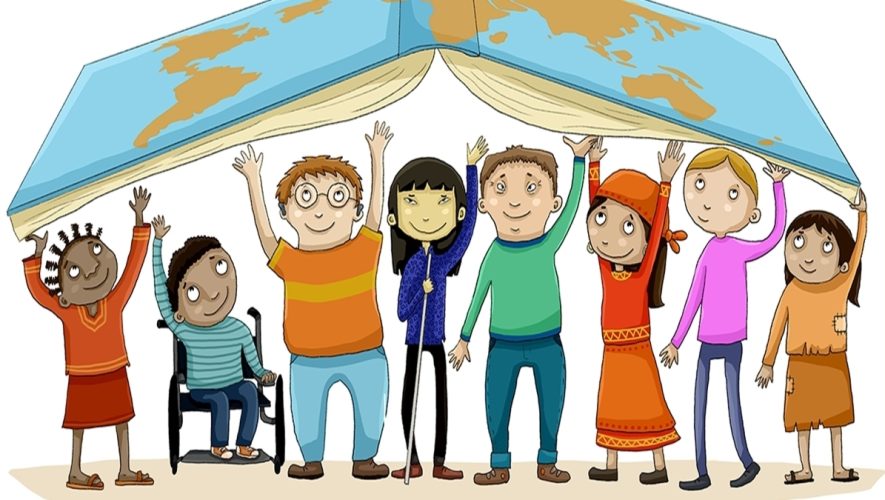The following community resources which are easily available need to be mobilized for ensuring inclusive education.
1. Neighborhood Schools itself
Most of schools imparting elementary education are established by community itself with grant-in-aid from Government, local authorities of district administration. Over the years, in most countries, localization as well as privatization of elementary education is taking place. Thus most elementary schools are managed by community groups, parents groups, local NGOs or school management committees.
Thus community resources should be motivated, convinced and motivated to ensure access of children with visual impairment to such schools. The right approach in regard may be sharing successful examples of inclusion and performance of such children in inclusive set up in nearby schools. Efforts should also be made to get the appropriate guidelines in respect of enrollment, provision of services and extending support services issued from the State Education Authorities.
2. Peer Group
In most developing countries, parents survive on daily wage work, agriculture or associated activities. Thus, they find it difficult to take the child to the school on their own. A sibling or student from the neighborhood should be convinced to guide the child for going to and returning from the school. Such buddy system helps the child while at school as well. It has been found that it is easy mobilize such human resources in the rural areas.
3. Class Teachers as Community Resources
Many teachers are also willing to take an additional responsibility of learning Braille, using assistive devices and understanding specific need of such children provided they are sensitized, imparted a short training and motivated properly in this regard. It is important understand that apart from teaching Pre- Braille, mobility, Braille or use of education devices which are taught by a special educator, the class teacher has also an important role to play. These roles include seating arrangement, direction of light in case of low vision children, speaking the text that is being written on black board, using alternative methods of evaluation, permitting use of Braille writing devices etc. Thus seeking involvement and participation of class teacher is of utmost importance.
4. Family Members as Readers
Involvement of mother, other family members of sibling in respect of reading books, assisting in recording, understanding of Braille and use of educational and mobility devices is very important. While most program focus on the child and her specific needs and do not realize and appreciate importance of involvement of such human resources in educational support activities at home of the child. Such human resources which are available at the home in the community of the child must be identified, sensitized and motivated to support such the child.
5. Child Preparatory Services
Many countries now have facilities for play groups, pre-school child preparatory services, Montessori classes, Kindergarten for “seeing” children. The concerned authorities should be motivated to extent such facilities to children with visual impairment as well. Inclusion must start at pre-school level and such service providers should be motivated to establish such facilities for such children as well. It would however require support of Special Educators in respect of meeting specific needs of such children.
6. Low Vision Assessment Services
Most developing countries have a vast network of ophthalmic clinics, vision centers and eye hospitals. These entities confine their services to eye health or ophthalmic care and do not extend services of vision assessment, low vision care, provision of low vision device and vision stimulation. The ophthalmic and optician fraternity should be motivated to include and provide these services to children with visual impairment as well. A large of children with low vision, those with galloping myopia and such eye ailment will benefit from these services.
7. Financial Resources
The concept of charity in most developing countries gives the impression that each and every expense on education, books, educational material, school fees etc. should be provided by State or NGOs promoting such education. It is however essential to convince parents and family members to support education of a child with visual impairment like they do in case of a seeing child. They should be motivated to consider education of children at par and extend financial support in case of education of such a child. They should also be informed and enabled to avail scholarships and other concessions and benefits available in case of education of such a child.
8. School Uniform, Boarding & Lodging etc.
Very essence of inclusive education is that the child with visual impairment stays with family like any other child and avails all the facilities at home like any other family member. This results into a significant contribution by the family members which in case of residential education is incurred by State or schools itself. The parents should be motivated to extend all facilities of uniform, school meals, transport and educational material as they do in case of their seeing children.
9. School Facilities from Community Resources
Once such a child is in school, she is entitled to get all the benefits of mid-day meal, educational material at concessional rates and seek exemption from school fee available to other non-affording students as per school norms. Many countries in the developing world provides elementary education free-of-cost and extend other support. In this way, child with visual impairment shall be entitled to all facilities available to seeing children and special facilities available to children like herself.
10. Special Educational and Mobility Devices
In many countries, such devices are available either free of cost or at affordable cost, subject to income level of parents. The parents must avail of these schemes and enable the child to get all the devices. Similarly, many NGO, INGOs and local authorities provide Braille books, low vision devices and audio books either free of cost or at affordable cost. The school authorities and parents should be shared this information and should be enabled to avail these benefits.
11. Support of Service Clubs
Many service clubs like Lions Clubs, Rotary Club, Round Table and Inner Wheel and many country specific clubs have taken initiatives on supporting such education. The Lions Clubs in many countries has established Braille production units, low vision clinics and ophthalmic support units. The parents and members of community should be guided and enabled to avail support from such initiatives.
12. Travel
Many countries provide special concessions to all children for the purpose to travelling to school in public transport. Whereas children with visual impairment are provided free transport. Once child joins an inclusive school, she would be eligible to avail either concessional or free travel in the public transport thus make her education more affordable.
13. Educational Loans
In many countries, the National Governments have launched schemes for providing educational loans at very low rate of interest to students who wish to pursue higher or professional education. The authorities promoting education of children with visual impairment need to persuade such agencies to provide such loans or micro credit to such students at par or at favorable terms and conditions.
To sum up, there are huge community resources which already exist or could be made available easily to support inclusive education of children with visual impairment. The point however remains as to who would identify and establish such resources and enable individuals, parents and family members to avail these resources. I leave it to prudence to participants to debate and work out a country or region specific mechanism in this regard. This is to reiterate that by mobilizing these community resources, it would certainly be possible to make inclusive education more effective, affordable and result oriented. Let us put all out efforts in the direct direction and in the right manner with the single objective of holding each child with visual impairment with hand and leading her to the school – and thus leading her to life.
Other Related Posts:
Universal Design for Inclusive Schools




Greetings,
I wasn’t aware of some of the material that you wrote about so I want to just say thank you for posting.
-Amanda